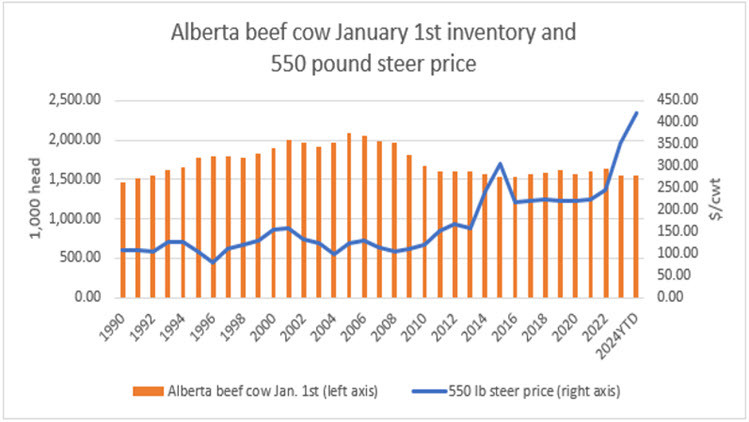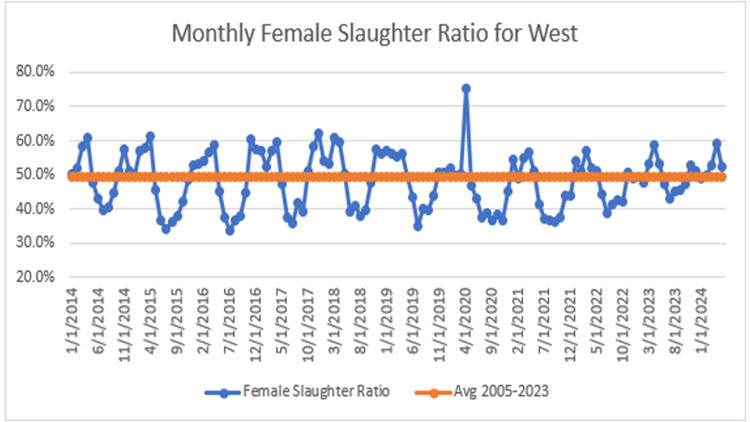Government mail service may be affected by the Canada Post labour disruption. See how to send and receive government mail during this time.
See event listings and more articles in this edition of Agri-News: July 15, 2024 issue
“A burning question for many is when will the Alberta cattle sector see a rebuild of its cow herd,” says Ann Boyda provincial livestock market analyst with the Alberta government. “Typically, what is needed are high calf prices and adequate precipitation. Both factors seem to be currently working in the sector’s favour, but the sector sits in limbo.”
Moisture has been direly needed after compounding years of drought. The June 27, 2024 Agricultural Moisture Situation Update had forecast widespread rain for much of the province for the first week of July. The 30-day trends in precipitation patterns were reported to have been near normal and many areas have received adequate moisture, except for a dry area west of Red Deer. Although July may still see the return to hot drier conditions, typically more so in the south, pasture and tame hay conditions are rated as 66% good to excellent, according to the July 9, 2024 Crop Report.
“Improved moisture conditions are but one supporting factor needed to trigger a sector rebuild,” explains Boyda. “Prospects for future profitability are essential. High calf prices should theoretically stimulate new or expansion of cattle herds, but recent record high prices have not had this effect.”
The average price of 550-pound steers for the first half of 2024 in Alberta is estimated at $420.69/hundredweight but cow inventory levels seem unaffected. With a smaller calf crop anticipated, strong prices are expected to continue.
So, what else is at play? Revenue is part of the equation. Expenses are the other. Hay prices reached over $270/ton in the spring of 2024 and remained well above the 5-year and 10-year average of $195/ton and $155/ton, respectively.
Figure 1. Alberta beef cow January 1st inventory and 550-pound steer price

“Rebuilding cattle herds can take 5 to 7 years,” says Boyda. “The last beef cycle was lengthy, nearly 14 years, from 2008 to 2022. Western Canadian slaughter climbed back to levels of 2.6 million by 2022. Live cattle imports contributed over 200,000 head to help sustain the capacity. Year-to-date (YTD) (May 2024), Alberta live cattle import volume was 190,173 head, 26% over a year ago, valued at $630.8 million or 49.4% higher than YTD 2023.”
Figure 2. West cattle slaughter and Alberta live cattle imports

“Another indicator of whether the sector is entering a rebuild phase is that of the female slaughter ratio (percentage of heifer and cow slaughter to total cattle slaughter),” says Boyda.
The average female slaughter ratio for the period 2005 to 2023 was 49.5% for West Canada. The pattern for the first 5 months of the year (apart from the COVID market disruption in spring 2020) has been similar for the last few years ranging from 49% to 59%. Where patterns differ is during the following 6 months. July 2015 and July 2016 show evidence of expansion with lower female slaughter ratios of 34.1% and 33.5%, respectively. In comparison, July 2023 witnessed female slaughter ratios of 43%.
Figure 3. Monthly female slaughter ratio for West

“Although there are more incentives for producers to retain heifers and rebuild their herds, the journey is likely to be gradual,” explains Boyda. “With June fed heifer prices exceeding $260/hundredweight and the average 2024 spring bred heifer price of $3303/head, over 42% higher than last year, letting go of heifers has been a favoured option by some producers.”
Contact
Connect with Ann Boyda for more information:
Phone: 780-422-4088
Sign up for Agri-News
Start every Monday with the week’s top agricultural stories and latest updates.
Read about all things agriculture at Alberta.ca/agri-news